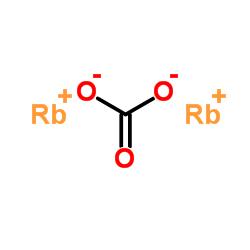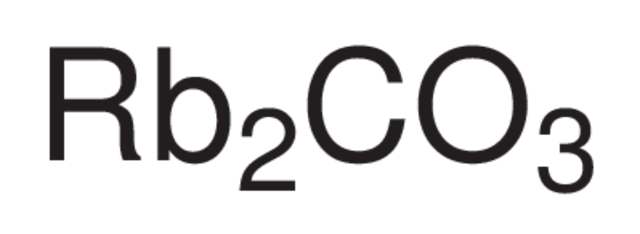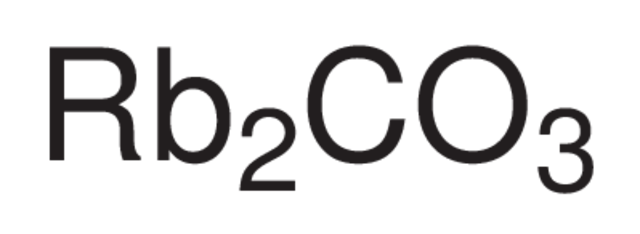碳酸铷, 99.9% metals basis,Rubidium carbonate
产品编号:西域试剂-WR364675| CAS NO:584-09-8| MDL NO:MFCD00011188| 分子式:Rb2CO3| 分子量:230.94
本网站销售的所有产品仅用于工业应用或者科学研究等非医疗目的,不可用于人类或动物的临床诊断或者治疗,非药用,非食用,
| 产品名称 | 碳酸铷, 99.9% metals basis |
|---|---|
| 英文名称 | Rubidium carbonate |
| CAS编号 | 584-09-8 |
| 产品熔点 | 837 °C |
| 产品沸点 | 333.6ºC at 760mmHg |
| 产品闪点 | 169.8ºC |
| 精确质量 | 229.808334 |
| PSA | 63.19000 |
| 外观性状 | 无色单斜晶体,吸湿的 |
| 溶解性 | soluble |
| 稳定性 | 稳定性和反应性: 要避免的物料:氧化物,水分,潮湿,酸,空气。 要分解的产品:一氧化碳和二氧化碳。 |
| 储存条件 | 贮存: 将密器密封,储存密封的主藏器内,并放在阴凉, 干爽的位置。 |
相关文档
化学品安全说明书(MSDS)
下载MSDS质检证书(COA)
相关产品
| 符号 |

GHS07 |
|---|---|
| 信号词 | Warning |
| 危害声明 | H315-H319-H335 |
| 警示性声明 | P261-P305 + P351 + P338 |
| 个人防护装备 | dust mask type N95 (US);Eyeshields;Gloves |
| 危害码 (欧洲) | Xi:Irritant; |
| 风险声明 (欧洲) | R36/37/38 |
| 安全声明 (欧洲) | S26-S36/37/39-S37/39 |
| 危险品运输编码 | NONH for all modes of transport |
| WGK德国 | 2 |
| RTECS号 | FG0650000 |
Synonym:Dirubidium Carbonate; Dirubidium Monocarbonate; Carbonic Acid, Dirubidium Salt Section 2 - COMPOSITION, INFORMATION ON INGREDIENTS
Risk Phrases: None Listed. Section 3 - HAZARDS IDENTIFICATION EMERGENCY OVERVIEW
Hygroscopic (absorbs moisture from the air).Air sensitive. Potential Health Effects Eye: May cause eye irritation. Skin: May cause skin irritation. Ingestion: May cause irritation of the digestive tract. May cause central, peripheral, and autonomic nervous system effects. Peripheral nervous system effects are characterized by muscular weakness, paresthesias, numbness in limbs, unsteadiness and difficulties in walking and standing. Inhalation: May cause respiratory tract irritation. May cause effects similar to those described for ingestion. Chronic: Effects may be delayed. Section 4 - FIRST AID MEASURES Eyes: Flush eyes with plenty of water for at least 15 minutes, occasionally lifting the upper and lower eyelids. Get medical aid. Skin: Get medical aid. Flush skin with plenty of water for at least 15 minutes while removing contaminated clothing and shoes. Wash clothing before reuse. Ingestion: Never give anything by mouth to an unconscious person. Get medical aid. Do NOT induce vomiting. If conscious and alert, rinse mouth and drink 2-4 cupfuls of milk or water. Inhalation: Remove from exposure and move to fresh air immediately. If not breathing, give artificial respiration. If breathing is difficult, give oxygen. Get medical aid. Do NOT use mouth-to-mouth resuscitation. Notes to Physician: Section 5 - FIRE FIGHTING MEASURES General Information: As in any fire, wear a self-contained breathing apparatus in pressure-demand, MSHA/NIOSH (approved or equivalent), and full protective gear. During a fire, irritating and highly toxic gases may be generated by thermal decomposition or combustion. Non-combustible, substance itself does not burn but may decompose upon heating to produce irritating, corrosive and/or toxic fumes. Extinguishing Media: Substance is noncombustible; use agent most appropriate to extinguish surrounding fire. Use water spray, dry chemical, carbon dioxide, or appropriate foam. Section 6 - ACCIDENTAL RELEASE MEASURES General Information: Use proper personal protective equipment as indicated in Section 8. Spills/Leaks: Clean up spills immediately, observing precautions in the Protective Equipment section. Sweep up, then place into a suitable container for disposal. Avoid generating dusty conditions. Provide ventilation. Place under an inert atmosphere. Section 7 - HANDLING and STORAGE Handling: Wash thoroughly after handling. Use with adequate ventilation. Minimize dust generation and accumulation. Avoid contact with eyes, skin, and clothing. Keep container tightly closed. Avoid ingestion and inhalation. Handle under an inert atmosphere. Store protected from air. Storage: Store in a tightly closed container. Store in a cool, dry, well-ventilated area away from incompatible substances. Do not expose to air. Store protected from moisture. Store under an inert atmosphere. Section 8 - EXPOSURE CONTROLS, PERSONAL PROTECTION Engineering Controls: Facilities storing or utilizing this material should be equipped with an eyewash facility and a safety shower. Use adequate ventilation to keep airborne concentrations low. Exposure Limits CAS# 584-09-8: Russia: 0.5 mg/m3 TWA Personal Protective Equipment Eyes: Wear appropriate protective eyeglasses or chemical safety goggles as described by OSHA's eye and face protection regulations in 29 CFR 1910.133 or European Standard EN166. Skin: Wear appropriate protective gloves to prevent skin exposure. Clothing: Wear appropriate protective clothing to prevent skin exposure. Respirators: A respiratory protection program that meets OSHA's 29 CFR 1910.134 and ANSI Z88.2 requirements or European Standard EN 149 must be followed whenever workplace conditions warrant respirator use. Section 9 - PHYSICAL AND CHEMICAL PROPERTIES Physical State: Powder Color: white Odor: none reported pH: Not available. Vapor Pressure: Not available. Viscosity: Not available. Boiling Point: Not available. Freezing/Melting Point: 837 deg C Autoignition Temperature: Not applicable. Flash Point: Not applicable. Explosion Limits, lower: Not available. Explosion Limits, upper: Not available. Decomposition Temperature: Solubility in water: Specific Gravity/Density: Molecular Formula: CO3Rb2 Molecular Weight: 230.95 Section 10 - STABILITY AND REACTIVITY Chemical Stability: Stable under normal temperatures and pressures. May decompose on exposure to air. Conditions to Avoid: Incompatible materials, exposure to air, exposure to moist air or water. Incompatibilities with Other Materials: Air, moisture, strong acids, strong oxidizing agents. Hazardous Decomposition Products: Carbon monoxide, irritating and toxic fumes and gases, carbon dioxide, rubidium. Hazardous Polymerization: Has not been reported Section 11 - TOXICOLOGICAL INFORMATION RTECS#: CAS# 584-09-8: FG0650000 LD50/LC50: CAS# 584-09-8: Oral, rat: LD50 = 2625 mg/kg. Carcinogenicity: Rubidium Carbonate - Not listed by ACGIH, IARC, or NTP. Other: See actual entry in RTECS for complete information. Section 12 - ECOLOGICAL INFORMATION Section 13 - DISPOSAL CONSIDERATIONS Dispose of in a manner consistent with federal, state, and local regulations. Section 14 - TRANSPORT INFORMATION IATA Not regulated as a hazardous material. IMO Not regulated as a hazardous material. RID/ADR Not regulated as a hazardous material. Section 15 - REGULATORY INFORMATION European/International Regulations European Labeling in Accordance with EC Directives Hazard Symbols: Not available. Risk Phrases: Safety Phrases: S 24/25 Avoid contact with skin and eyes. S 26 In case of contact with eyes, rinse immediately with plenty of water and seek medical advice. S 28A After contact with skin, wash immediately with plenty of water. S 37 Wear suitable gloves. S 37/39 Wear suitable gloves and eye/face protection. S 45 In case of accident or if you feel unwell, seek medical advice immediately (show the label where possible). WGK (Water Danger/Protection) CAS# 584-09-8: 1 Canada CAS# 584-09-8 is listed on Canada's NDSL List. CAS# 584-09-8 is not listed on Canada's Ingredient Disclosure List. US FEDERAL TSCA CAS# 584-09-8 is listed on the TSCA inventory. SECTION 16 - ADDITIONAL INFORMATION N/A |










 浙公网安备 33010802013016号
浙公网安备 33010802013016号